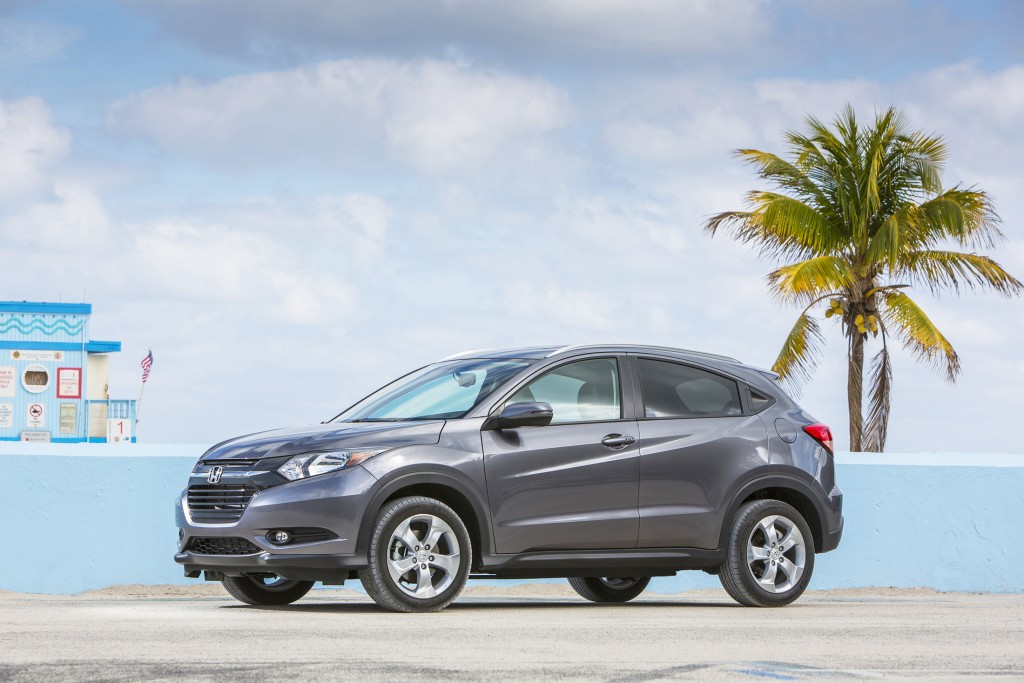By Derek Price
Automotive Writer
Car companies around the world are racing to develop compact crossover vehicles.
They all seem to think this is the next segment set to explode in sales, which is why you see cars like this — the 2016 Honda HR-V — cropping up on dealer lots this year.
And don’t let the pictures fool you. The HR-V looks like a big, galumphing SUV, but it’s actually closer in both size and price to the omnipresent Civic compact car.

The 2016 Honda HR-V is the newest entrant in the hot market for compact crossovers. It has the lines of a big SUV but is closer in size to compact sedans.
Compared to the Civic, the HR-V is slightly taller, slightly wider and a whopping 10 inches shorter in length, so it’s small enough to be both fuel efficient and easy to maneuver in tight city traffic.
While it’s certainly no SUV in terms of capability, the SUV-like shape gives this small car more practicality than its sedan or coupe siblings. You can fold the back seat flat to carry big, bulky items that wouldn’t fit so easily in a normal trunk.
Pricing starts at just $19,115, which is roughly $600 more than the Civic and competitive with similar upstarts like the Chevrolet Trax ($20,300), Mazda CX-3 ($19,960) and Jeep Renegade ($17,995, without air conditioning).
In an increasingly packed category, the HR-V’s upsides are its tight sense of construction, refined driving feel and, of course, Honda’s reputation. I also like how its body looks prettier and cleaner than most of the other micro-utes.
Its downsides are twofold and minor. One, it uses Honda’s standard touchscreen interface, which isn’t as intuitive or quick to respond as I’d like it to be. And two, it’s just not very fast. A 141-horsepower engine is adequate but hardly inspiring.

The HR-V’s back seat folds flat to make room for bulky items that wouldn’t fit into the trunk of a typical compact car.
To be fair, the same could be said of all its competitors, perhaps with the exception of the zippy Mazda. They’re all designed more for daintily sipping fuel than for making brawny power, and it shows in the HR-V’s budget-friendly highway rating of 35 mpg.
Honda offers the HR-V in three trim levels, all of which can be upgraded to all-wheel drive. The LX trim starts at $19,115 with a six-speed manual transmission or $19,915 with the continuously variable transmission (CVT).
The EX trim adds luxuries such as a touchscreen interface, Honda’s wonderful LaneWatch camera and push-button start, priced at $21,165. And the fancier EX-L adds leather seats, a navigation system, satellite radio and roof rails for $24,590.
If I were in the market for a new Civic, I’d take a close look at buying an HR-V instead. It’s priced for penny-pinchers but looks more stylish and can carry bigger cargo when you need the option.
At a Glance
What was tested?
2016 Honda HR-V AWD EX-L with navigation ($25,840). Options: None. Price as tested (including $880 destination charge): $26,720
Wheelbase: 102.8 in.
Length: 169.1 in.
Width: 69.8 in.
Height: 63.2 in.
Engine: 1.8-liter four-cylinder (141 hp, 127 lbs.-ft. torque)
Transmission: Continuously variable transmission
Estimated Mileage: 28 city, 35 highway
RATINGS
Style: 8
Performance: 5
Price: 9
Handling: 8
Ride: 7
Comfort: 6
Quality: 7
Overall: 7
Video Review:
2016 Honda HR-V
http://bit.ly/2016hr-v
Why buy it?
It has the price and efficiency of a compact car but looks more stylish and carries more cargo.
